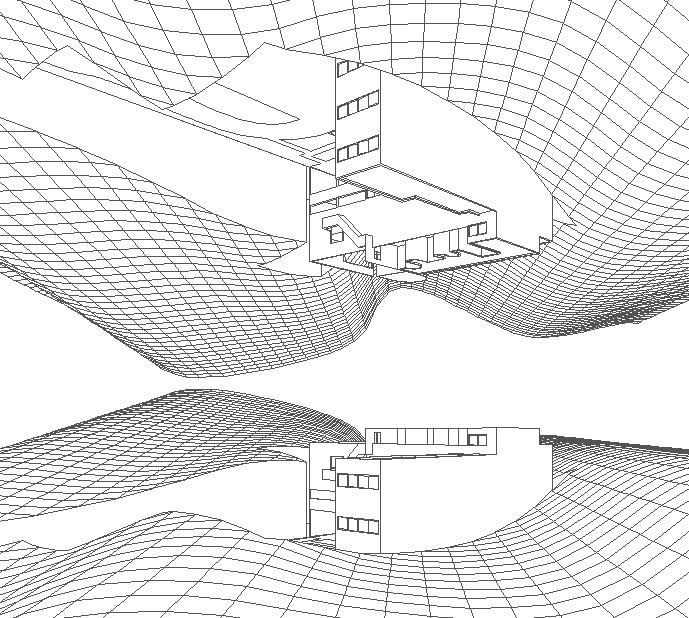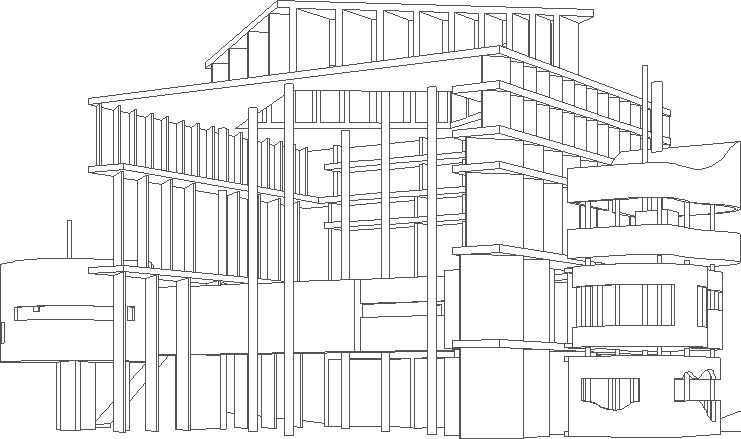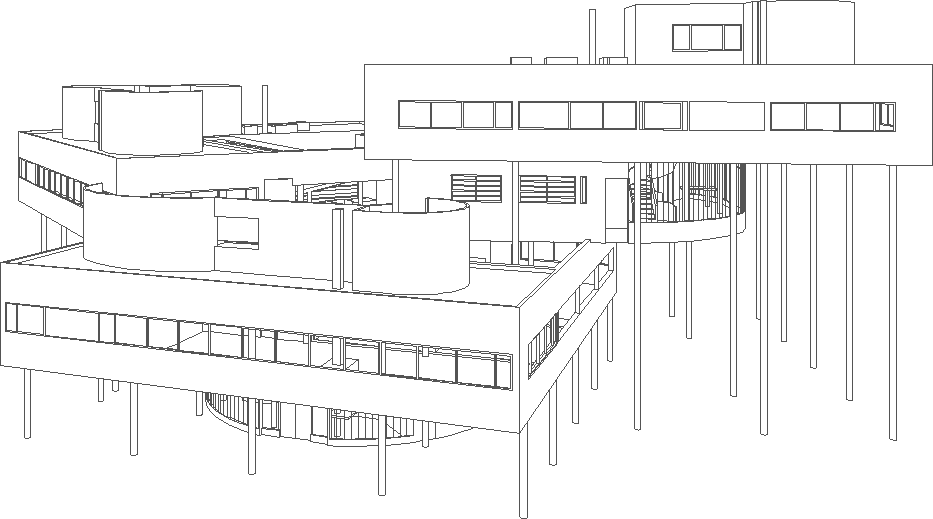2009.06.21 14:58
please comment or destroy, thank you
Like I already said:
"I can well see that scripting is an advancement in drawing dexterity with the aim of an advancement in production, but it's not altogether evident that scripting is an advancement in architecture."
abstract 0.0
Ichnographia Quondam
Advancements in virtual architecture, yes. But does an advancement in virtual architecture necessarily or automatically translate into an advancement in real architecture?
Is this an advancement in architecture?
Is this an advancement in architecture?

Is this an advancement in architecture?

Is this an advancement in architecture?

| |
2009.06.28 11:03
what is the difference between paradise & utopia?
The entire January 1972 issue of Du magazine (Swiss) is devoted to "Utopia: Visionärer Städtebau gestern und heute" (Utopia: Visionary Urban Design yesterday and today). Unfortunately, all the text is in German with not even an English summery.
Off hand, the only specific architect[ural] rendition of Paradise I can think of is Terragni's Paradiso (room) within the Danteum.
There are, however, many oasis reenactments (i.e., paradise) within architectural design. Learning from Las Vegas notes the 'oasis' aspect of the outdoor pool areas of the various hotels, and even Dubai (and it's artificial islands) and Abu Dhabi may be considered reenactments of the oasis/paradise paradigm rather than following an utopian model.
Paradise as the ultimate in real estate?
2009.06.28 12:00
what is the difference between paradise & utopia?
Perhaps also related is Robert Geddes's "The Forest Edge" in A.D. 52 11/12-1982. The opening paragraphs:
"In 1753, Marc Antoine Laugier, the French theorist, proposed the primitive hut as the foundation of architecture in his Essai sur l'architecture. The frontispiece of his second edition shows the muse indicating architecture's true source and origin by pointing to a hut at the edge of the forest made of four trees acting as columns.
I suggest an additional interpretation of Laugier's engraving. I believe the muse is directing our attention not only to the building as the reconstructed forest [or the forest reenacted], but also to the edge of the forest itself. She is pointing out the ideal habitat of man, the forest edge, where the woodlands and grasslands meet."
and later...
"While the current focus of ecological and conservationist movements has given new life to Thoreau's view of wilderness, these political movements do not propose that man should live in the wild. The hold that man is a visitor and should leave no trace of his passing."
Without having now (re-)read all of "The Forest Edge", I nonetheless get the sense that the text may evoke ideas that are both paradisic and utopian, ending with examples of practical design applications.
Is the current "green" movement in some ways an advanced combination of the paradise and utopian paradigms?
2009.06.28 16:43
what is the difference between paradise & utopia?
I'd say both paradise and utopia are man-made [intellectual] constructs, but paradise is metaphoric and utopia is paradigmatic.
2009.07.01 15:36
what is the difference between paradise & utopia?
...I found your intitial query thought provoking in that, as you say, one doesn't really hear about architects designing (a) paradise.
When PG,UB suggested research into landscape design of the Middle Eastern and Islamic world, I began to think about the Alhambra--a fortress/palace/city as paradise.
Regarding heterotopia, for some reason, I began to think of the novel Platform--notions of sex tourism within 'paradise'. Also got out my Foucault Reader and read "Space, Knowledge and Power" where Foucault says a few things about ancient Roman baths and their eventual demise throughout Europe--not exactly places of paradise, but public, social places centered around activities of pleasure.
You say you are planning to design a paradise. Care to share a little more about that?
| |
2009.07.21 10:26
I smell a Vorläufer
"I like the list; like chapters, like lessons, like evolutionary stages, like different floors of a building I'd love to design, like a row of restaurants while you're perpetually hungry."
...the curatorial architect as elevator operator of life.
2009.07.22 17:40
"This market is a game changer"
What I'm more asserting is that lucrative goals are more objective and "the greater good" is more subjective (if not altogether ephemeral).
What's the object of the new (architecture) game?
What's the subject of the new (architecture) game?
2009.07.30 08:06
Rant Magazine... "Artist"/Designer? submittals
Exponential Potential Architecture
1. Architecture plus Weaponization
2. Architecture minus Weaponization
3. Architecture times Weaponization
4. Architecture divided by Weaponization
5. Architecture greater than Weaponization
6. Architecture less than Weaponization
7. Architecture to the power of Weaponization
8. the Weaponization root of Architecture
2009.08.02 14:34
inspiring Maya Linked Hybrid edge
"So an afterlife does not exist for us per se, but instead an afterlife occurs for that which exists between us. When an alien civilization eventually bumps into Earth, they will immediately be able to understand what humans were about, because what will remain is the network of relationships: who loved whom, who competed, who cheated, who laughed together over road trips and holiday dinners. Each person's ties to bosses, brothers, and lovers are etched into the electronic communiqués. The death switches simulate the society so completely that the entire social network is reconstructable. The planet's memories survive in zeros and ones."
from "Death Switch" in Sum
Don't underestimate the oblivion of a deleted archive, however.
2000.01.03:
PD writes:
What about the notion of life? In order to call a composition as a work of architecture there must be a life in it. A life around it does not make it architecture, I think. The composition must embrace a life style, must be an accompaniment of a life style but not be the focus of it. The objects which are for perception only, cannot be called architecture. They are called sculpture.
SL replies:
What PD writes comes across as very true as a reasonably way to approach "what is architecture?" as opposed "what is sculpture?" And for the most part I agree with the notion that architecture accommodates life. So I then ask if this 'definition' must be broadened to include all built forms that once accompanied life and a life style, but over time have come to no longer do so. I am thinking of ancient ruins, be they Stonehenge, the Pyramids, the Parthenon, the cave temples of India, etc. These are commonly referred to as examples of architecture, yet today they are clearly "objects which are for perception only." Have these architectures become architecture/sculpture hybrids? Furthermore, no one now lives in Le Corbusier's Villa Savoye, nor, it might be argued, does the life style around which the Villa Savoye was designed to accompany now exist. Is the Villa Savoye a master work of modern architecture that is now an "object which is for perception only?" Or is it merely that the 'life style" the Villa Savoye now accompanies is one where great buildings (if they're lucky) become cultural shrines, where the buildings now accommodate our 'perceptual worship'?
How much of life is really spent in perceptual worship?
"Meanwhile, the question posed in 1918 by the Hermitage's first commissar and futurist Nikolai Punin, "Is a Museum a Shrine or a Factory?" is yet to be answered."
from Content
| |
2009.08.14 10:44
hence creative ingenuity
creative : resulting from originality of thought, expression, etc.; imaginative
ingenuity 1 : the quality of being cleverly inventive or resourceful; inventiveness 2 : cleverness or skillfulness of conception or design 3 : an ingenious contrivance or device
creative [architecture] by itself; that's relatively easy.
2009.08.16 12:01
Postmodernism sucks... discuss
...where we see Postmodern architecture related to the growing trend of realism in film (including cinematic pornography). Not exactly a parallel development, but more where realism in films opened up designers/architect's minds to a more realistic approach to designing buildings/environments. Prior to realism, most films were an adapted form of theater/stage production. Realism in film presented 'real' situations within 'real' settings. [Yes, there is the omnipresent irony of films themselves not being real to begin with.]
aside: Does anyone else remember the paparazzi catching Jackie O. after she saw I am Curious (yellow).
Outside the stage directions of the Modern Movement there is the quickly found serendipity of everyday living/experience, and this realm of no clear rules beyond the immediate context of the situation made it easy for (what Portoghesi called) 'the end of prohibitionism'.
Postmodern architecture would not have happened without a certain frame of mind, and that frame of mind was becoming more and more prevalent within films of the later 1960s and 1970s.
Strictly within architecture itself, Scully, in 'How things got to be the way they are now', finds the genesis of Postmodern architecture with Kahn and Kahn's Beaux Arts education and Roman-ness (wrapped together via Piranesi's plan of the Campo Marzio).
It seems worth noting that the two most significant architects to come out of the 'Strada Novissima' are Frank Gehry and Rem Koolhaas/OMA.
2009.08.16 14:07
Postmodernism sucks... discuss
I think you have to first define what 'that' is.
Otherwise, architecture still pretty much operates within the 'realm of no clear rules beyond the immediate context of the situation'.
2009.08.16 15:44
Postmodernism sucks... discuss
Many of the architects who utilized "the application of content and forms and motifs that are deliberately identifiable in cultural and historical terms" 30 years ago still design that way today (if they are still active and/or alive).
The first Greenaway film I saw was The Draughtsman's Contract in 1983, 27 years ago, and that's the kind of murder mystery I'm talking about.
The first Tarantino film I saw was Pulp Fiction in 1994 and soon after that architecture started becoming very virtual.
|